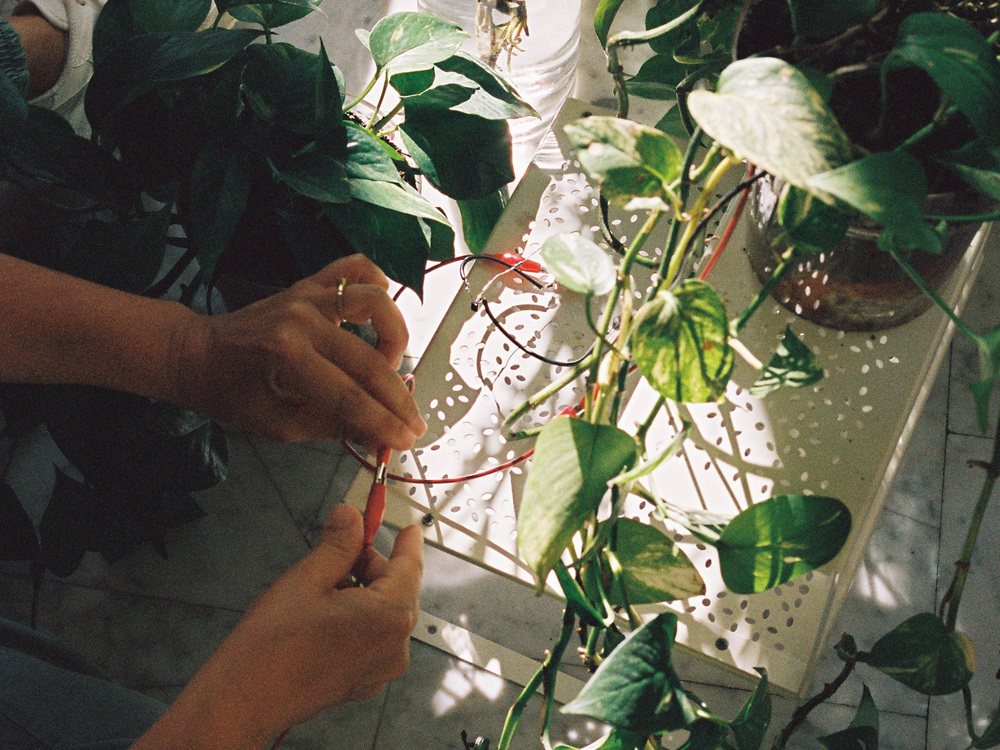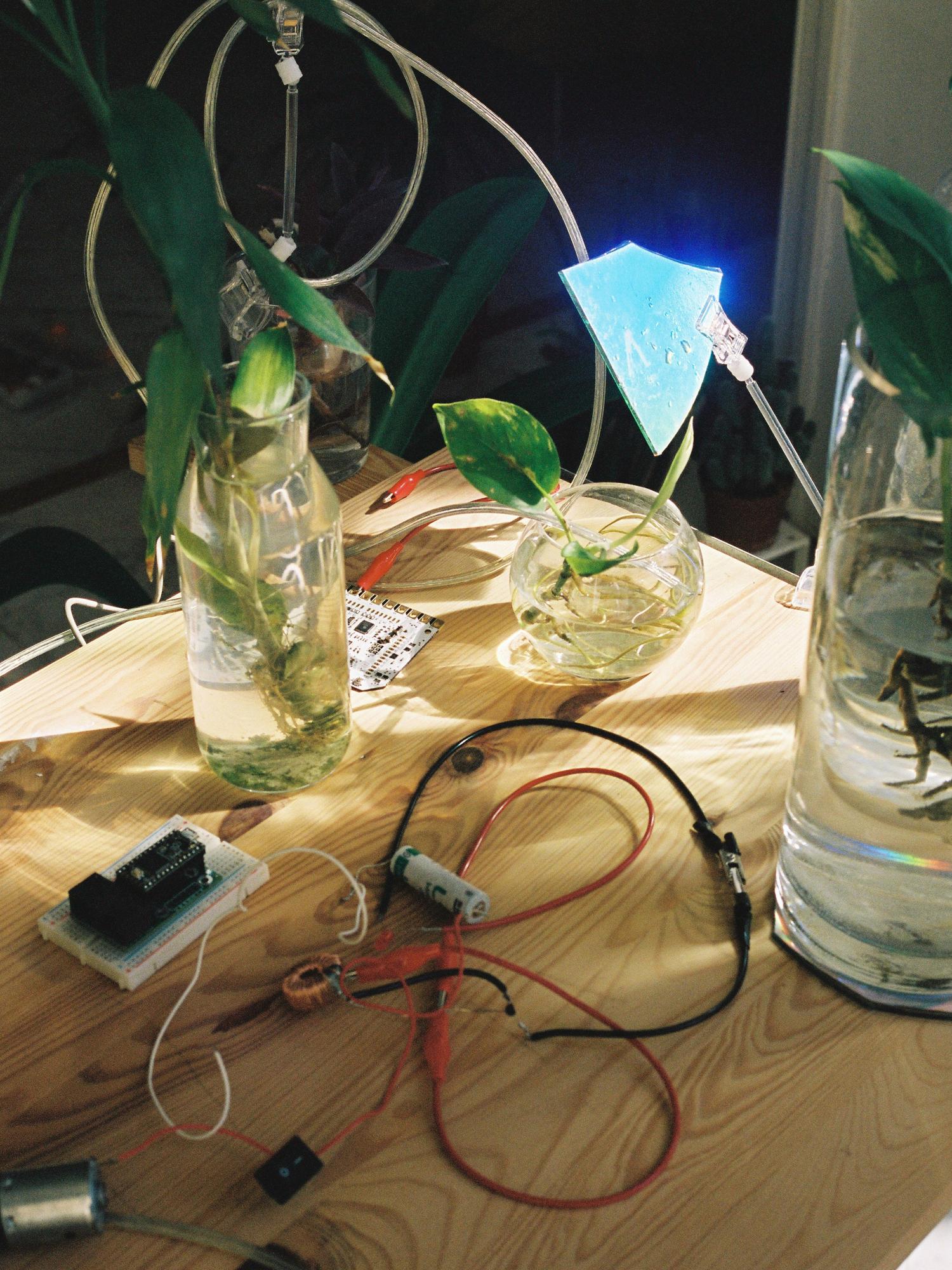Photo Microbial Fuel Cell
Biodesign Investigation(2020-2021)

Site specific Installation - Saye Interview
2021 Photo Microbial Fuel Cell
Locations
2020: Centre for Creative Solutions, Lovinac, CR, 2020
2021: Contorno Urbano, L'Hospitalet de Llobregat, ES, 2021
← take me back
( ENG )
See below for Spanish.
Photo Microbial Fuel Cell is the result of an ongoing investigation and project, iniciated in August 2020 as part of an artístic residency focused on “Non-human intelligences” at the Centre for Creative Solutions in Lovinac, Croatia.
The investigation began with the challenge of developing a permanent and sustainable installation, without a stable source of electricity, nor access to the internet.
The appropriation of electricity on behalf of nature as a means to enhance its network was the initial speculation. Later our investigation evolved towards the relationship between nature and electricity, and therefore exploring the use of photosynthesis as a source of electrical energy.
Plants, algae and cyanobacteria, known as photoautotrophs, are the only organisms capable of realizing photosynthesis, a process in which they are able to synthesize their own nutrients through the generation of carbohydrates and oxygen from carbon dioxide, water and light energy.
These carbohydrate molecules contain covalent bonds that store energy. Part of this organic matter is utilized for the plant's growth, whilst 70% is discarded in the rhizosphere layer of the soil. Here, active microorganisms surround the plant's roots and break down these bonds as part of their own metabolism, liberating electrons in the process.
By capturing these electrons, we create a photo microbial fuel cell (P-MFC), a device that converts light into electrical energy.By closing the circuit using electrode extensions we create a path allowing the current to flow into a LED diode, creating a self sufficient, living source of electricity.

( ES )
Photo Microbial Fuel Cell es el resultado de una investigación y proyecto en curso, iniciado en agosto de 2020 como parte de una residencia artística enfocada en “Inteligencias no humanas” en el Centro de Soluciones Creativas en Lovinac, Croacia.
La investigación comenzó con el desafío de desarrollar una instalación permanente y sostenible, sin una fuente estable de electricidad, ni acceso a internet.
La apropiación de la electricidad por parte de la naturaleza como medio para potenciar su red fue la especulación inicial. Posteriormente nuestra investigación evolucionó hacia la relación entre la naturaleza y la electricidad, explorando así el uso de la fotosíntesis como fuente de energía eléctrica.
Las plantas, las algas y las cianobacterias, también conocidas como fotoautótrofos, son los únicos organismos capaces de realizar la fotosíntesis, un proceso en el que pueden sintetizar su propio alimento mediante la generación de carbohidratos y oxígeno a partir de dióxido de carbono, agua y energía luminosa.
Dichas moléculas de carbohidratos contienen enlaces covalentes que almacenan energía. Parte de esta materia orgánica es utilizada para el crecimiento propio de la planta, pero hasta el 70% es deshechada en la capa rizosfera del suelo. Aquí, microorganismos activos rodean las raíces de la planta y rompen estos enlaces como parte de su propio metabolismo, liberando electrones en el proceso.
A través de la captura de los electrones, creamos una celda de combustible foto microbiana (P-MFC), un dispositivo que convierte la energía luminosa en energía eléctrica.
2021 Photo Microbial Fuel Cell
Locations
2020: Centre for Creative Solutions, Lovinac, CR, 2020
2021: Contorno Urbano, L'Hospitalet de Llobregat, ES, 2021
← take me back
( ENG )
See below for Spanish.
Photo Microbial Fuel Cell is the result of an ongoing investigation and project, iniciated in August 2020 as part of an artístic residency focused on “Non-human intelligences” at the Centre for Creative Solutions in Lovinac, Croatia.
The investigation began with the challenge of developing a permanent and sustainable installation, without a stable source of electricity, nor access to the internet.
The appropriation of electricity on behalf of nature as a means to enhance its network was the initial speculation. Later our investigation evolved towards the relationship between nature and electricity, and therefore exploring the use of photosynthesis as a source of electrical energy.
Plants, algae and cyanobacteria, known as photoautotrophs, are the only organisms capable of realizing photosynthesis, a process in which they are able to synthesize their own nutrients through the generation of carbohydrates and oxygen from carbon dioxide, water and light energy.
These carbohydrate molecules contain covalent bonds that store energy. Part of this organic matter is utilized for the plant's growth, whilst 70% is discarded in the rhizosphere layer of the soil. Here, active microorganisms surround the plant's roots and break down these bonds as part of their own metabolism, liberating electrons in the process.
By capturing these electrons, we create a photo microbial fuel cell (P-MFC), a device that converts light into electrical energy.By closing the circuit using electrode extensions we create a path allowing the current to flow into a LED diode, creating a self sufficient, living source of electricity.

( ES )
Photo Microbial Fuel Cell es el resultado de una investigación y proyecto en curso, iniciado en agosto de 2020 como parte de una residencia artística enfocada en “Inteligencias no humanas” en el Centro de Soluciones Creativas en Lovinac, Croacia.
La investigación comenzó con el desafío de desarrollar una instalación permanente y sostenible, sin una fuente estable de electricidad, ni acceso a internet.
La apropiación de la electricidad por parte de la naturaleza como medio para potenciar su red fue la especulación inicial. Posteriormente nuestra investigación evolucionó hacia la relación entre la naturaleza y la electricidad, explorando así el uso de la fotosíntesis como fuente de energía eléctrica.
Las plantas, las algas y las cianobacterias, también conocidas como fotoautótrofos, son los únicos organismos capaces de realizar la fotosíntesis, un proceso en el que pueden sintetizar su propio alimento mediante la generación de carbohidratos y oxígeno a partir de dióxido de carbono, agua y energía luminosa.
Dichas moléculas de carbohidratos contienen enlaces covalentes que almacenan energía. Parte de esta materia orgánica es utilizada para el crecimiento propio de la planta, pero hasta el 70% es deshechada en la capa rizosfera del suelo. Aquí, microorganismos activos rodean las raíces de la planta y rompen estos enlaces como parte de su propio metabolismo, liberando electrones en el proceso.
A través de la captura de los electrones, creamos una celda de combustible foto microbiana (P-MFC), un dispositivo que convierte la energía luminosa en energía eléctrica.